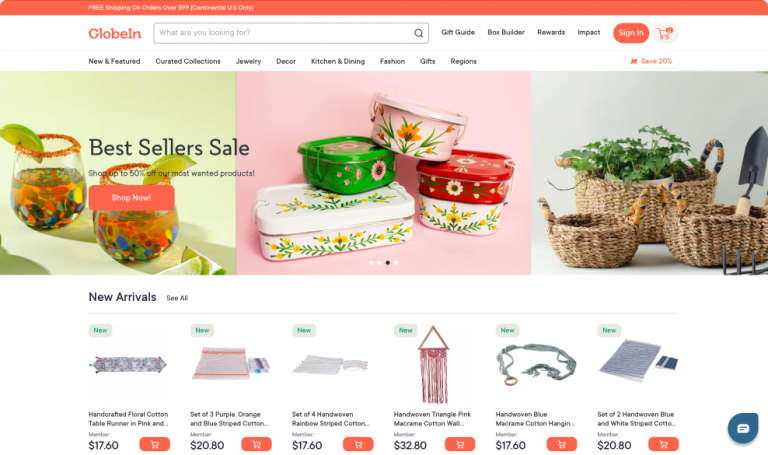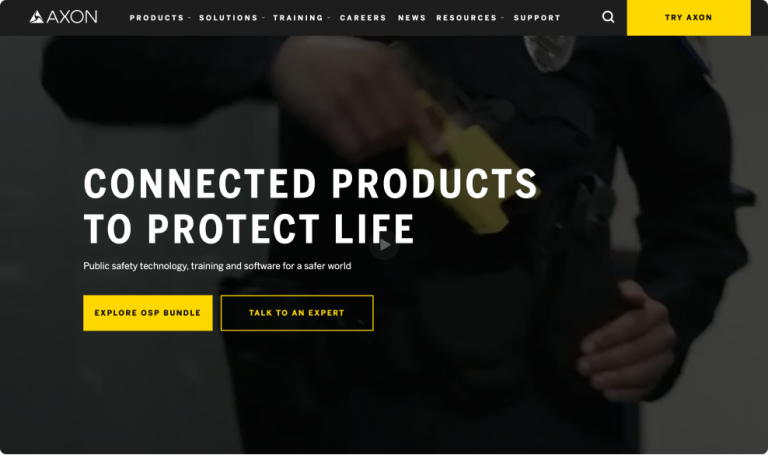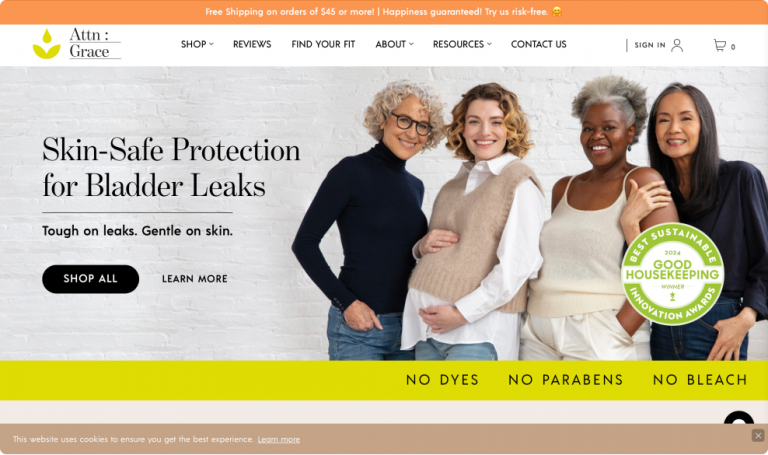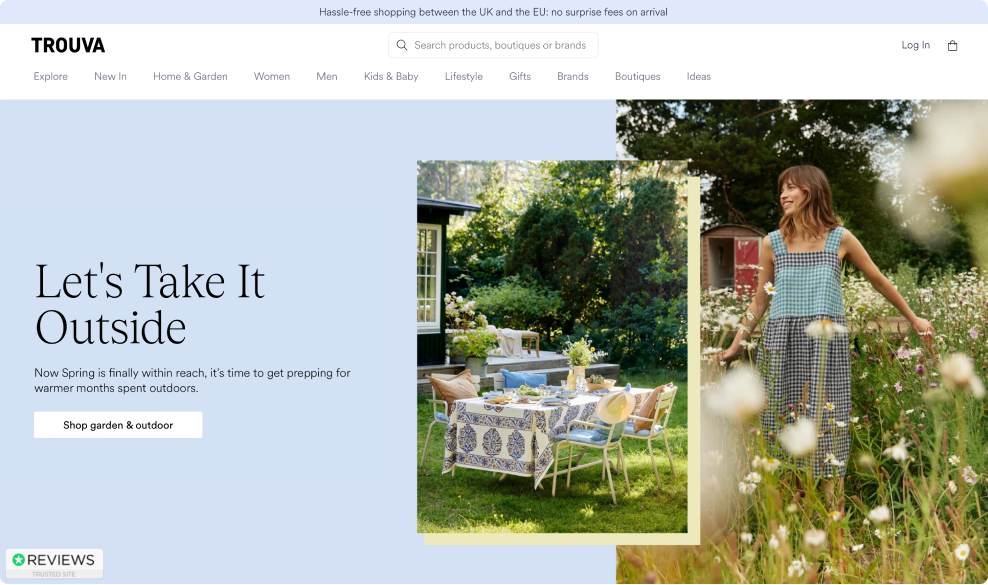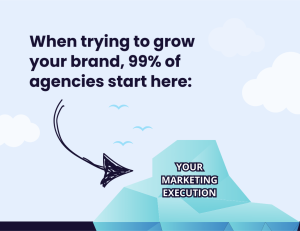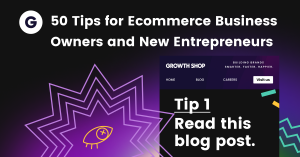Snapshot:
A few years back, mattress brand Nectar Sleep (Resident Home) approached us to run the growth function of their business.
Their annual revenue was sitting around $10M. Our task was to turn them into an undeniable global market leader.
And that’s exactly what we did:

In the years we worked with them, we:
Let me explain how…
Since 2019, we’ve been using our Growth Iceberg Strategy to drive over $1B in ecommerce growth.
We’ve used this growth strategy to help over 45 DTC brands break through scaling ceilings, and cross the chasm from $3–5M ARR to over $10M (and beyond).
241% Growth, With 100% YoY Revenue Lift in 2022-2023 From 98% Increased
Marketing Spend.
Increased Subscriptions by 148% While Decreasing Cost per New Subscribers by 16%.
Successfully Launched the Digital Consumer Division of Taser, With a 600% ROAS.
With this strategy, we helped Nectar Sleep get:
Not because we pumped out more ads… and not because Meta worked some kind of magic…
But ALL because of a high level growth strategy that solidified the foundations of the business and made scaling a breeze.
This SAME strategy has helped us take brands from $1M to $5M.
From $5M to $10M… and from $10M to $100M+.
This SAME strategy will help you achieve:
But it ONLY works for DTC eComm brands with a PROVEN product-market fit (i.e. you’ve hit an MRR between $250k and $500k, but know you could be bigger). If you DON’T have a proven product then you can leave this page (sorry).
Now, if you have a proven product… then pay close attention to every word on this page.
The Growth Iceberg Strategy solves 3 big problems for DTC brands trying to scale
“We’ve hit a revenue ceiling, and any attempt to break through it fails”
Have you hit an MRR of $250 – 500k, but struggle to consistently go beyond that figure? Does it seem like your business goes off the rails every time you try to scale?
The Solution: A Growth Iceberg Strategy that shores up the very foundations of your business and primes it to scale easily and successfully.
“Meta doesn’t perform for us as well as it use to (or like it seems to for everyone else)”
Did Meta help you hit your current ARR, but now paid ads aren’t helping to increase it? Do you see Meta working wonders for other brands and feel like you’re doing something wrong?
The Solution: A Growth Iceberg Strategy that works right at the core of your business and makes Meta the easy part of scaling.
“Our ROAS is good, but our PNL doesn’t match it”
Do your Meta numbers look impressive, but your profitability is telling a different story? Do you feel like your day-to-day decisions are driving growth, but that feeling is not reflected in your financial reports?
The Solution: A Growth Iceberg Strategy that lets you make daily and weekly financial decisions in the context of what your CFO will see, giving you more control over your profitability.
All you need to do is dive deeper, and see the whole Growth Iceberg
With this strategy, scaling becomes a cinch.
See, 99% of agencies (and even brands themselves) direct their growth and scaling efforts towards their marketing execution:
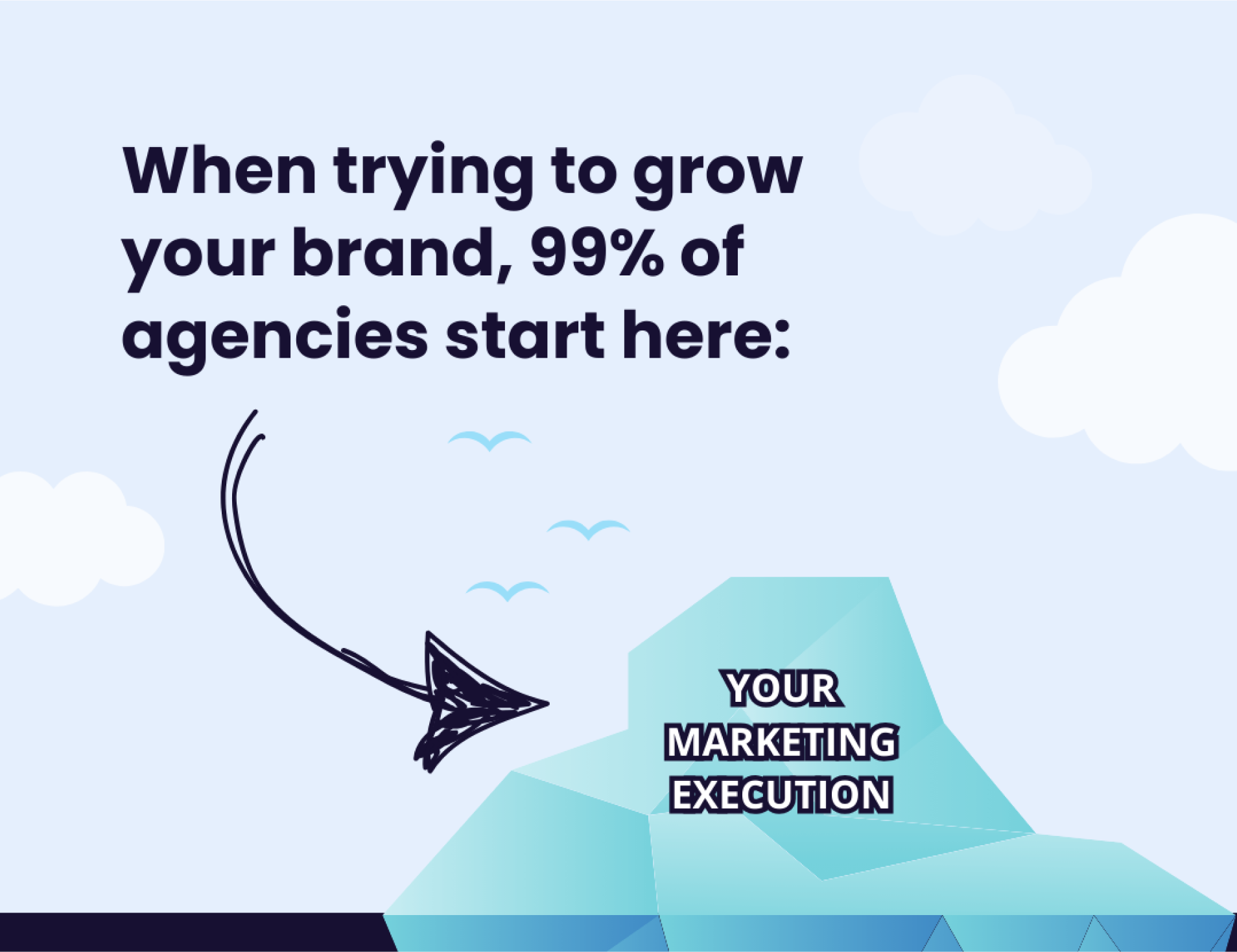
But if we zoom out a bit, you can see that marketing is not the whole story; it’s quite literally just the tip of the iceberg:
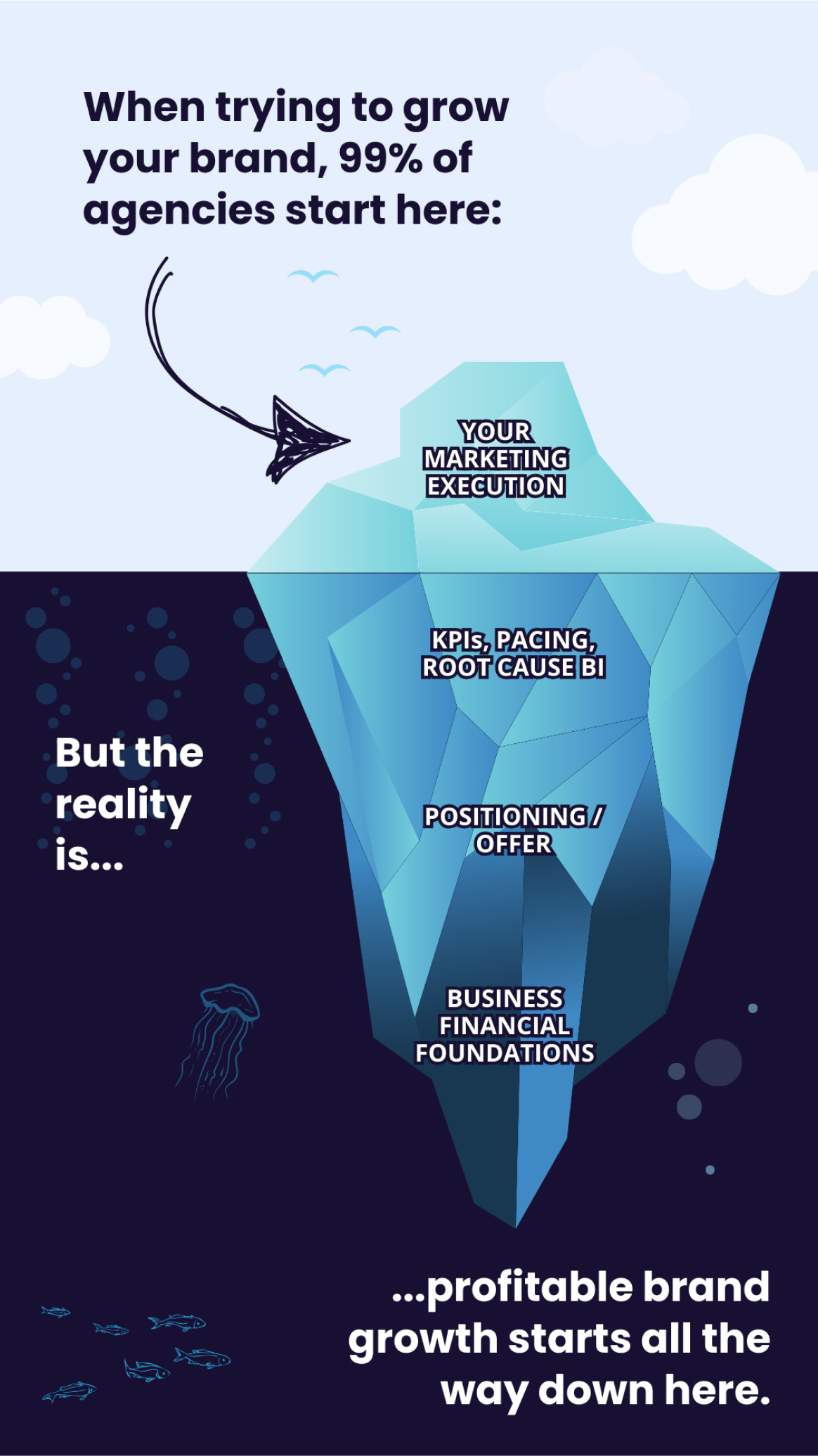
There’s way more to brand growth than simply what your target market can see.
After doing this for 5+ years, here's what we've found works best for brand growth: The Growth Iceberg Strategy
The Growth Iceberg Strategy starts right at the very base, and works upward. Getting all of that stuff under the surface right makes what everyone can see (i.e. your marketing) that much more effective.
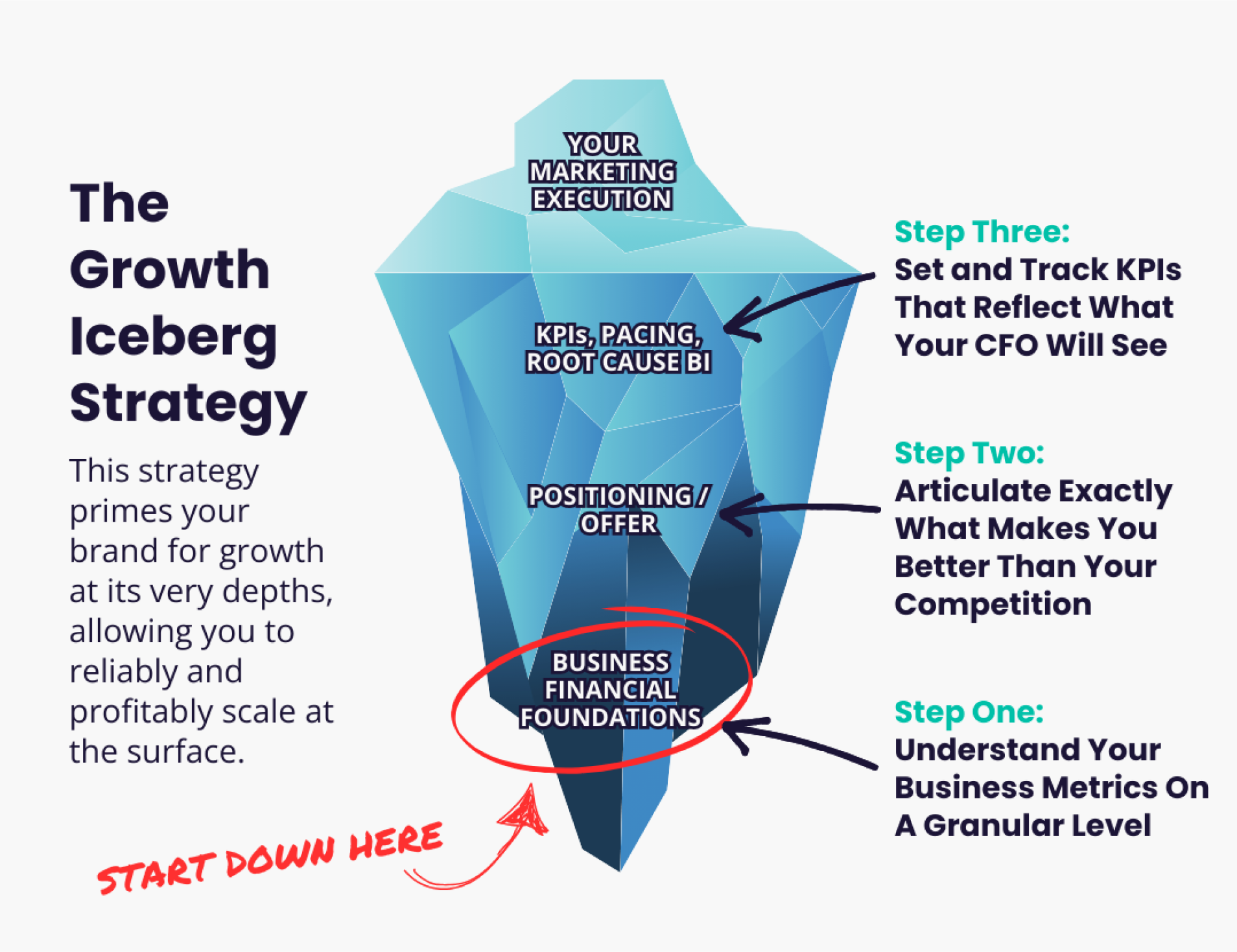
Which means easier, faster, more reliable growth. Plain and simple.
Here’s how we make the Growth Iceberg work for any DTC brand:
Step 1: Understand Your Business Metrics On A Granular Level (aka Business Financial Foundations)

This first step is about aligning the numbers you see, and what your CFO will report on. We do this by setting up tracking sheets that reflect your TRUE profitability.
These are all numbers and metrics that, for the most part, only get scrutinized on a monthly or quarterly basis. Which is pretty unhelpful when you’re trying to make weekly, daily, or even hourly decisions.
But when you build out the tracking sheets that I’m about to show you, you can make short-term moves that will make sense in the grand scheme of long-term profitability.
So – there’s a couple of layers to this kind of tracking. Here’s what our first level looks like:
This mostly tracks orders and revenue, but it already goes even further than that. We split these numbers by:
- Repeat orders,
- New orders,
- Repeat contribution…
All that good stuff.
I consider this to be basic tracking – it’s going to get you pretty darn close to giving you CFO vision. BUT it doesn’t yet take into account some key data points, such as the variability of profitability for different SKUs.
In saying that though, this basic growth tracking will work really well if you have a single SKU business.
But I recommend that most brands go a layer deeper, and also create something that will show you your TRUE profitability at a unit and order level – like this:
We include profit variables like:
- The different charges for what card customers use to pay (e.g. Amex vs Mastercard vs Diners)
- The pick-and-pack cost based on different SKU sizes
- Shipping costs for different SKU sizes
Any part of your business that has variable costs and profits – track it. The more granular you can get here, the better.
Step 2: Articulate Exactly What Makes You Better Than Your Competition (aka Positioning / Offer)
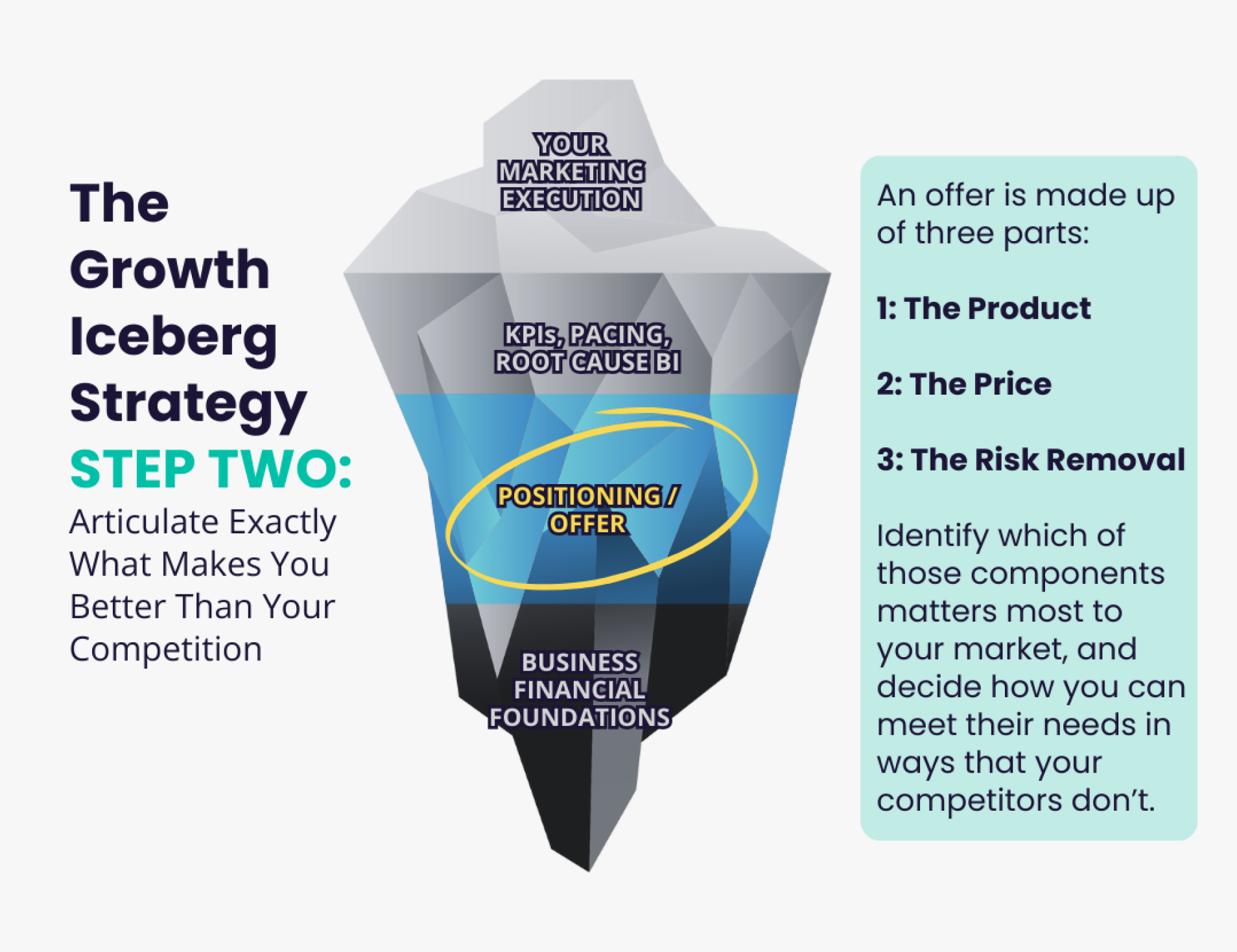
This step probably has the biggest flow-on effect into simplified, more effective marketing. Because if you can pinpoint exactly what makes your offer better than that of your competitors, that’s half the battle won.
An offer is made up of three components:
- The product: the unique problem you’re solving
- The price: what customers need to pay to solve the problem
- The risk removal: the confidence you give them that you can do what you say
Creating a compelling offer is about identifying which component/s matter most to your market, and meeting their needs in ways that your competitors don’t.
For Nectar Sleep, we had over 100 competitors in the space. We narrowed it down to the top two: Casper, and Purple.
We all offered pretty comparable products, so competing based on product was out of the question. This meant we had to differentiate using the other two levers.
We identified “risk removal” as the most effective tool at our disposal – changing a mattress sucks. People don’t want to run the risk of having to swap their mattress out again in a few months time.
Here’s what we did with that knowledge:
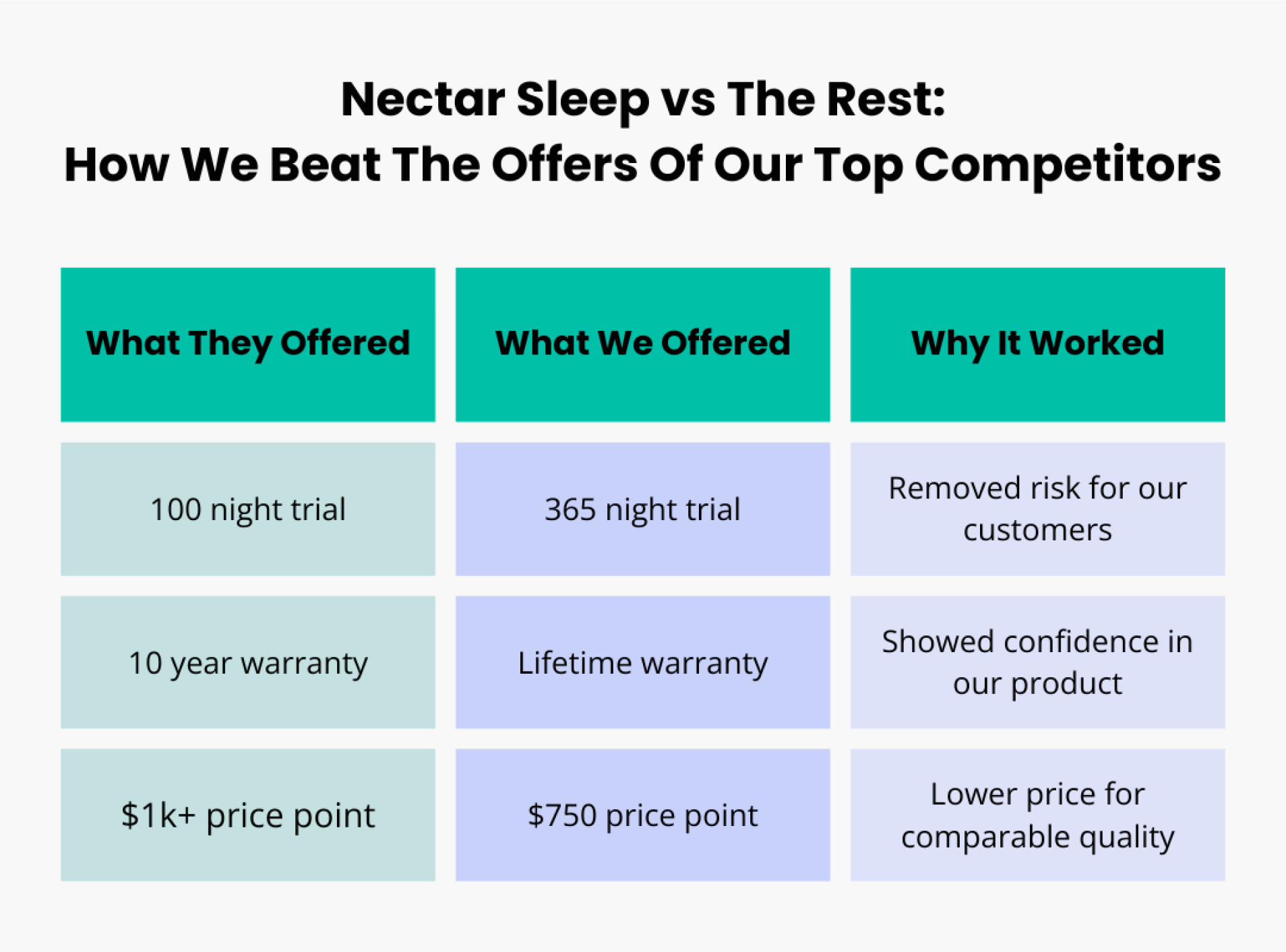
Our confidence in our product gave our customers confidence that they would be happy with their purchase, successfully removing the risk.
We also beat them on price – because our margins allowed us to. An important point here is that “price” is typically the first lever brands reach for, but it’s simply not feasible for everyone.
And that’s absolutely not the deal breaker that many think it is.
One of our clients, Attn: Grace (an incontinence pad company), was competing with Amazon (I think it’s probably pretty obvious where this is going…).
Here’s Attn: Grace’s product page. Note the price – 57c per unit:

…And here’s what their customers could get from Amazon:
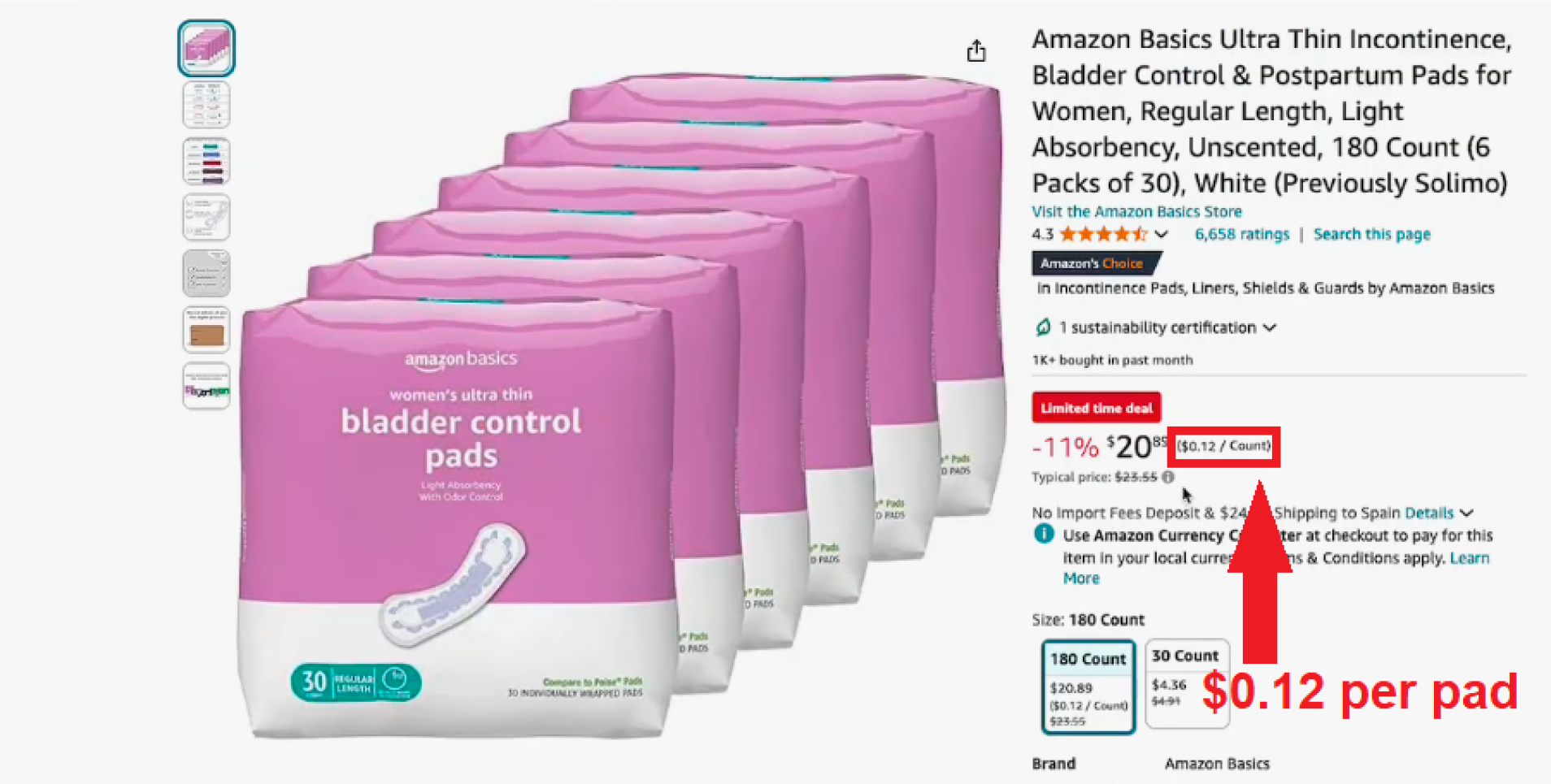
87% Revenue Growth in 3 Months, With a 369% Increase
in New Customer Sales.
12c per unit. From a profitability perspective, competing on price was a no go.
But if we think about who needs these products, risk reduction via product quality is WAY more important than a lower price.
Attn: Grace’s pads (in comparison to the Amazon product) had:
Attn: Grace’s pads (in comparison to the Amazon product) had:
With something as high-risk as incontinence, you would think that their customers would absolutely be willing to pay almost 5x for a higher-quality product.
And they did:
Step 3: Set and Track KPIs That Reflect What Your CFO Will See (aka KPIs, Pacing, and Root Cause BI)
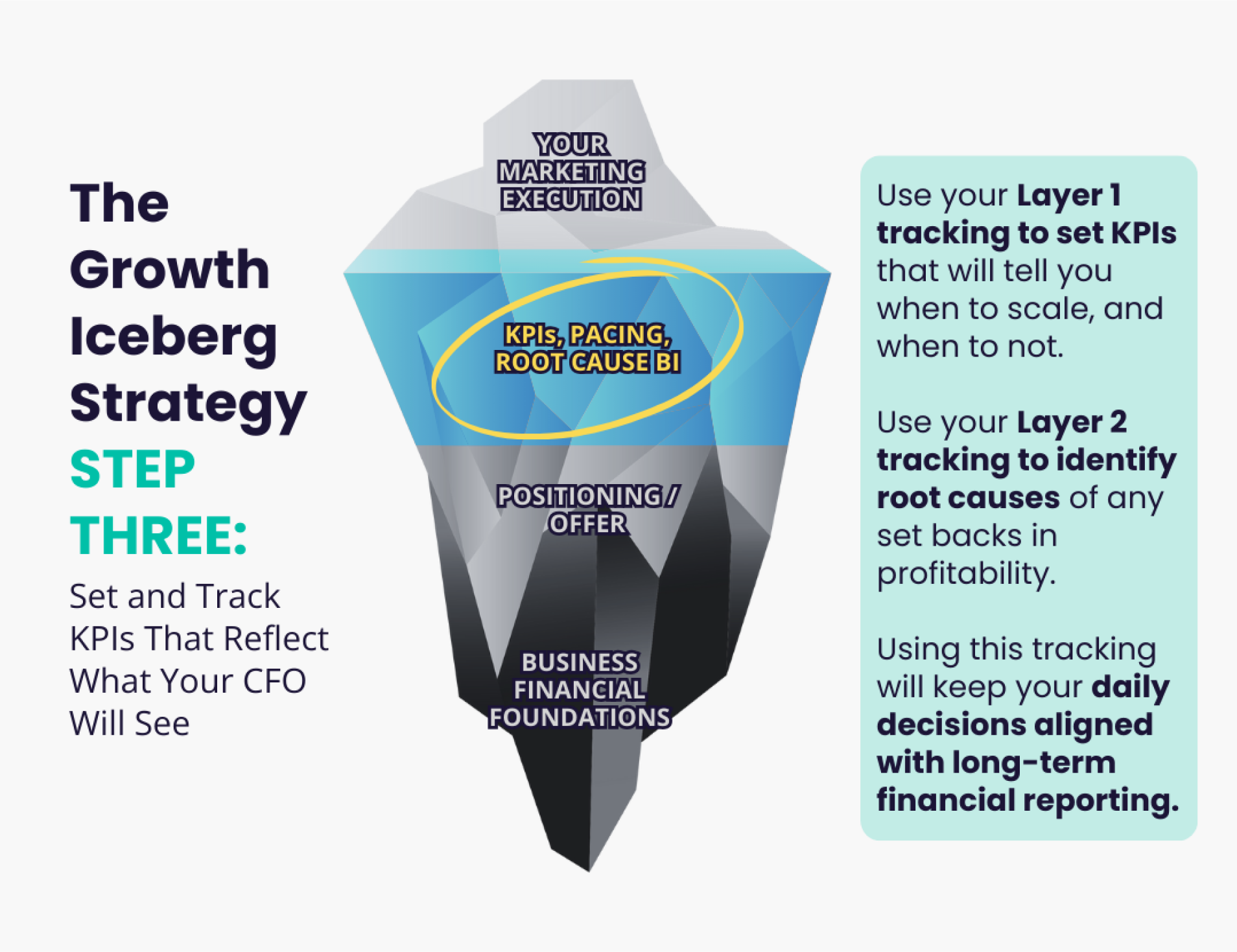
The final step is to take the tracking sheets from Step One, and use those numbers to set your KPIs – NOT Meta attributions like most brands do.
This ensures your everyday actions on that top layer of the iceberg (i.e. your marketing) are ALWAYS made in the context of profitability.
And with your offer and positioning nailed down first, you can now set your KPIs knowing that you’ve laid the groundwork for some solid marketing execution – meaning there’s no need to play small with your targets.
Specific KPIs will vary from brand to brand, but to give you a general idea, here’s how we use our growth tracking for this step:
You’ll be looking at the first layer of tracking for this step, as you’ll be setting KPIs for broader metrics like MER, not variables like card charges.
Let’s look at that first tracking sheet again:
The metrics highlighted on the right hand side (total online sales, repeat contribution, MER, and conversion rate) are what you want to set KPIs for, because these are the numbers that will tell you when to scale.
For example, if repeat contribution is at 30 – 35%, it’s go time.
This first layer of tracking also means that you can easily see when you need to pump the brakes.
But the key to successful growth is not just knowing when to back off, but WHY – that’s when you’ll need to look at your second layer of tracking to find the root cause.
Having that more granular perspective will clearly show not only where your upper problems are coming from, but what’s driving them.
It gives you the ability to get on top of issues that are stagnating (or regressing) your growth as they happen, rather than months down the line when your CFO is breathing down your neck.
TO RECAP…
Unlocking your brand’s growth while staying profitable is as simple as:
- Tracking your business metrics on a microscopic level to see your TRUE profitability
- Ensuring your offer meets your target customers’ deepest needs BETTER than your competition
- Using your new tracking to set and meet KPIs that align your daily decisions with long-term reporting
Here are a few reasons why the Growth Iceberg Strategy works:
- It’s easy to see what is driving profitability and what is pulling on the handbrake. The granular perspective gives you way more business intelligence than your Meta attributions ever could.
- Your offer and positioning is clear and compelling, simplifying your marketing execution. When your offer is strong (and meets your customers’ needs better than your competition), all you need to do is get the word out.
- Your daily and weekly decisions get made in the context of quarterly financials. You can view your shorter-term decisions exactly how they’ll be reported on in the long-term.
But don’t just take my word for it – here’s what our strategy has done for other leading DTC eComm businesses:
Idle Brands: Over 40x MRR In 9 Months

Idle Brands
From $110K per Month to $4.8M per Month in 9 Months Through Omnichannel Marketing
Trouva: From Seed Round To Top 5 Brand Growth
Scaled from Seed Round to Top 5 Fastest Growing Consumer Brands in Europe (Successfully Exited).
GenealogyBank: 36% CPA Reduction + 33% Increased Conversion Volume
36% Blended CPA Reduction While Increasing Conversion Volume by 33%
Note: These are just a FRACTION of the results we’ve gotten with this strategy. We’ve used this method to grow over 45 DTC eComm brands, so you get the point… The Growth Iceberg Strategy has been mega-successful both for us AND our clients.
The neat thing about the Growth Iceberg Strategy is that it creates a positive feedback loop.
When you put in the work on those bottom layers, everything you do on the surface (as long as you stay within your set parameters) will ensure that everything looks good right at the very base of your business.
Get this right, and stuff like this happens:
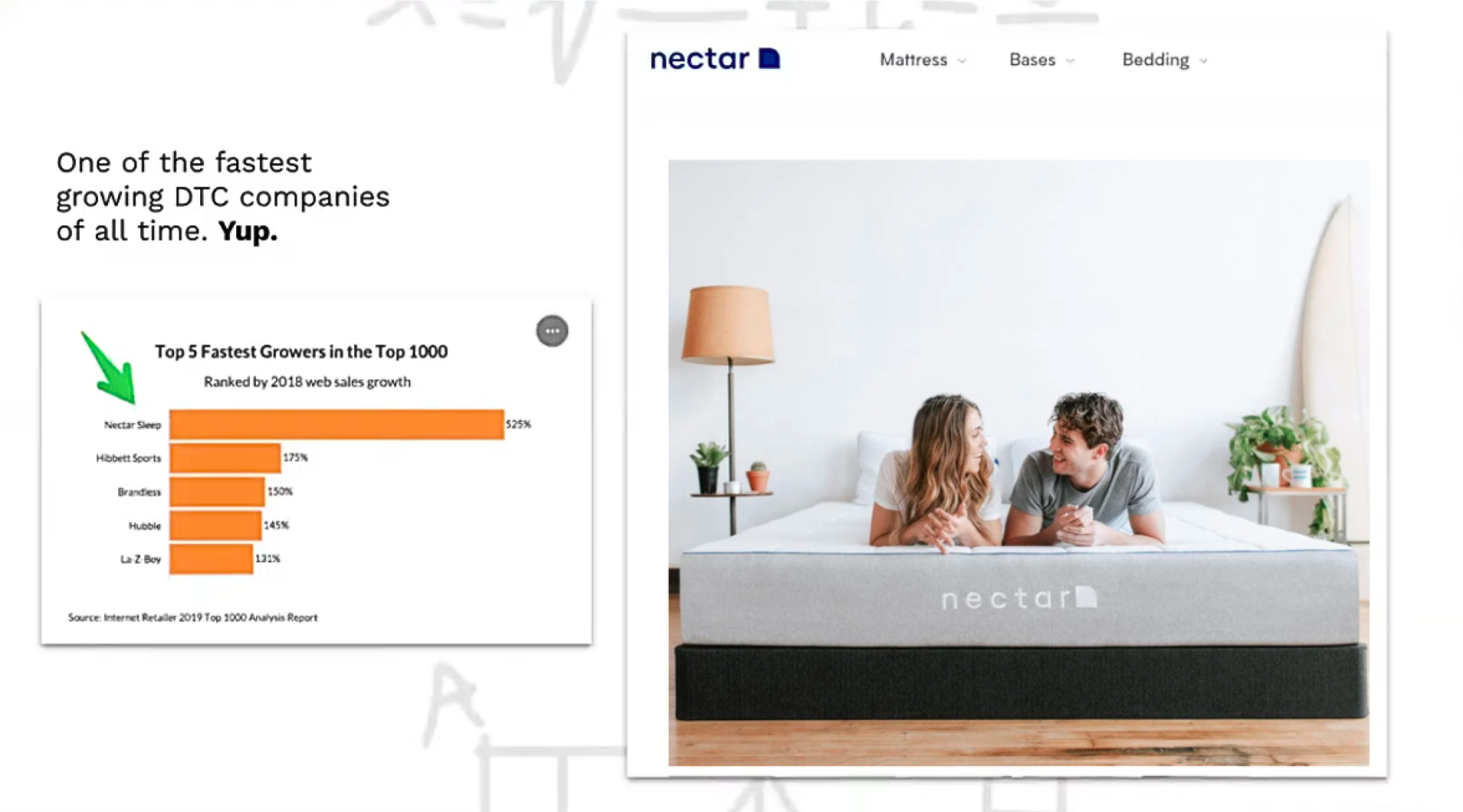
Boom. Your brand is scalable and profitable.
DISCLAIMER: I have to tell you…results like this are not typical. We’ve been working in brand growth for 5+ years. Most businesses will scale incrementally as their PNL improves.
If you’d like to see how we can help you get this set up… so that you can easily and profitably break through your current ARR ceiling… you have two options:
Option 1
Take the step-by-step process I’ve laid out here, look at the examples of the process in action, and have a go at applying it to your own business. Looking at your growth beyond Meta attributions is nothing new.
We’ve just found a way to measure and track business metrics in a way that reflects your true profitability, and aligns short-term decisions with long-term growth.
Option 2
You can work with my team here at Growth Shop 1-on-1 to do all of this for (and with) you. Save time, money, and frustration trying to troubleshoot your stagnant growth on your own.
Plug into a ready-to-go growth team (AND their world-class data infrastructure) at a fraction of what it would cost you to hire, manage, train, and integrate them individually.
Together, we will:
- Plan and execute your growth strategy to get you from point A to point B
- Handle media buying across Meta and TikTok
- Build your CRM flows alongside your brand team
- Run selective CRO sprints in the areas of your funnel that need it
- Track, measure, and report using our in-house data powerhouse, GS IQ
Ready to pull your brand out of the growth rut? Book a discovery call (and get a FREE growth audit) below!
On this call we will:
- Evaluate your current situation. We’ll discuss where your brand is sitting right now and what your biggest growth challenges are.
- Discover where you want to go. Tell us exactly what your growth aspirations are for your business.
- Strategize how we can get you there. We’ll start mapping out a path to overcome your scaling challenges, and turn your DTC brand into a profitable growth machine.
Plus you’ll get a FREE growth audit just for booking a call. Even if you don’t feel like the Growth Shop team is the right fit for your business, you’ll walk away with a plan for your next steps towards profitable growth. Seriously.

